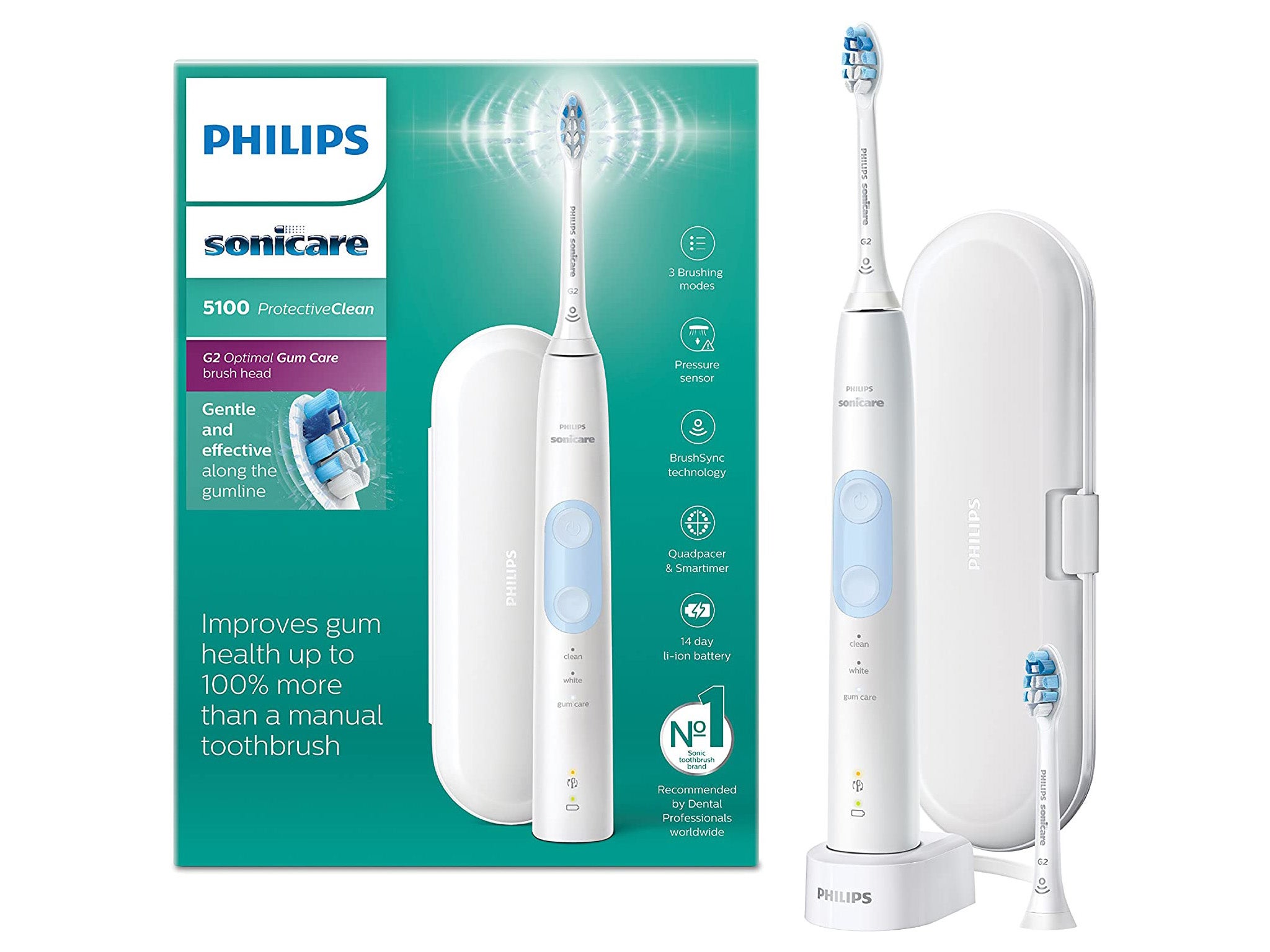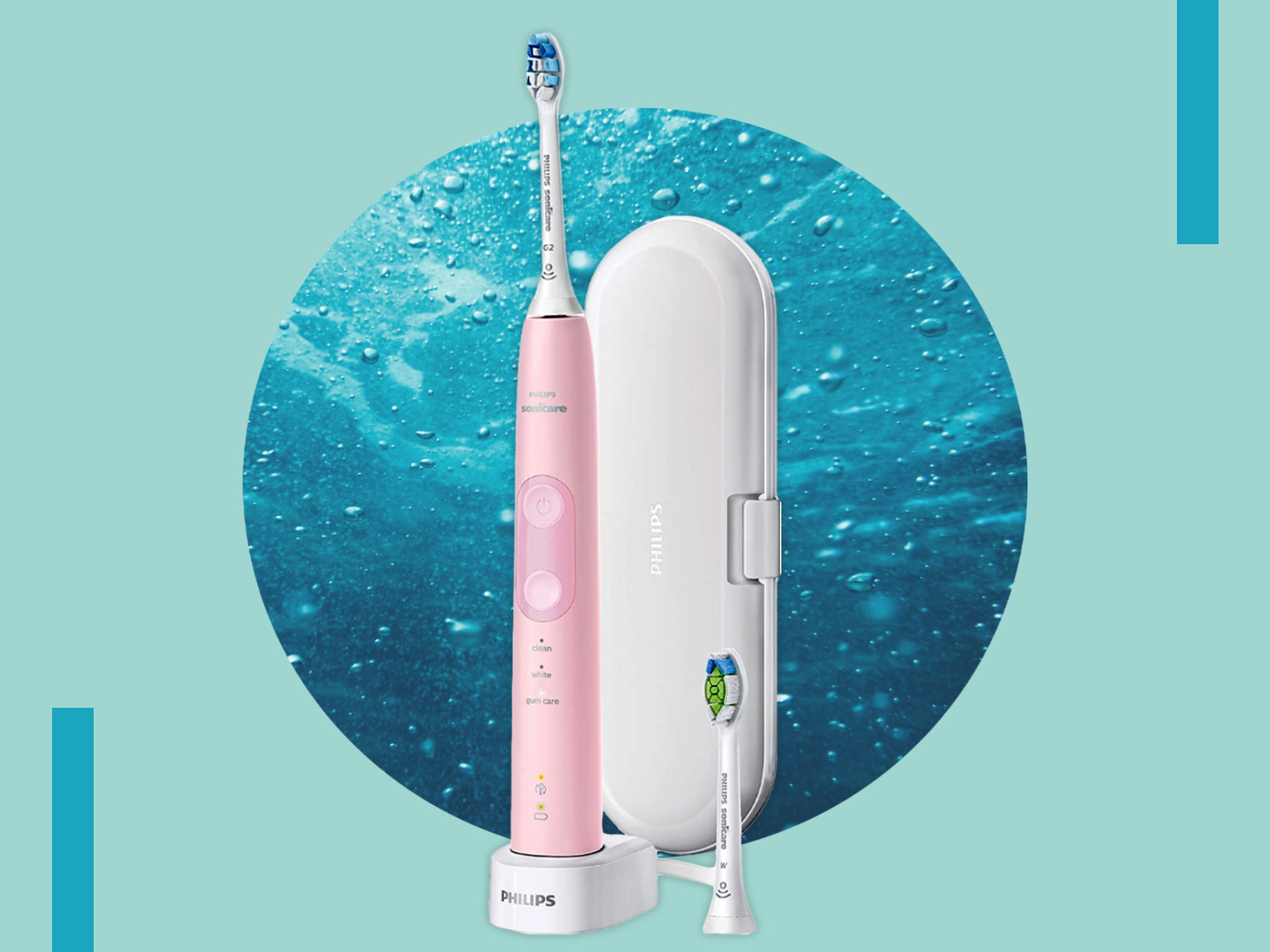1Philips sonicare protective clean 5100

Cleaning action: Sonic
Pressure sensor: Yes
Cleaning modes: Three – clean, whiten, gum care
Two-minute timer: Yes
30-second pacer: Yes
Travel case: Yes
Operating time (full to empty): Three weeks
Charging time: One hour
Design
The brush is rounded, ergonomic and very clean to look at, with two well-placed buttons – one to turn it on and one to select the cleaning mode – on the handle. Lightweight and with a nice smooth finish, the 5100 not only looks good but is also easy to keep hold of even when the handle gets wet.
It’s all about the design details with the 5100 and each brush head is slightly angled, which makes it very easy to get the brush into those awkward spots towards the back of the mouth, around the molars and premolars. There’s a raised ridge on the back of the handle, which stops the brush rolling away when you lay it flat and in terms of matching the décor in your bathroom (if that’s a priority), the 5100 is currently available in four different colours: black, navy, pink and white.
Features
The 5100 sits bang, smack in the middle of the protective clean range and differs from the other numbered brushes (4300 and 6100) because it’s the only one to feature three cleaning modes, but not have a different range of brushing intensities – the 4300 has two intensities and the 6100 has three.
However, the modes – “clean”, “white” and “gum care” – which are easily selected before you start brushing, are all you’ll need to benefit from the sonicare technology.
As with all electric toothbrushes the brush works on the principle that your mouth is split up into quadrants: upper left, lower left, upper right and lower right. On “clean” mode, you will experience the brush operating at its highest frequency for the recommended two minutes, with the quad-pacer interrupting the brush’s operation every 30 seconds to prompt you to move on to the next quadrant of your mouth. This means that by the time your two minutes is up you know you’ve systematically covered all your teeth.
Read more: Philips 5100 vs Fairywill pro P11
Selecting “white” or “gum care” means the pacer will still guide you through the initial two-minute clean before allowing another 30 seconds of cleaning for “white” and one minute for “gum care”. The brush will automatically reduce to a lower frequency of vibration too.
Another stand out feature of the 5100 is “brushsync”, which is the technology that allows the brush to alert the user when bristles are worn out and need to be changed. It does this via a microchip in the brush head that tracks the amount of time the bristles have been used for and stores the information in the handle.
You can also switch between brush heads from within the Sonicare range, all of which have different bristle configurations to suit different dental outcomes (from gum care to plaque defence) and the chip will still record how much time you’ve got left before you should change that particular brush head.
Finally, pressure sensors will let you know when you’re brushing too hard, helping to protect gums from over zealous brushing.
Cleaning and usage
If your new to sonic cleaning, the oscillating effect of the brush head can feel very strange – it feels (and sounds) more like something you would find to hand in a hygienist’s room. However, the protective clean range does have an introductory feature called “easy start”, which gradually increases the oscillating intensity over the first 14 outings, until you’re up to the fabled 31,000 strokes. Once you’re up to speed (you can turn the easy start mode off if you want to), the 5100 will deliver a thorough clean that really feels like it touches all four sides of a tooth rather than just the outward facing surface.
The 5100’s modes cover all dental hygiene targets and, once you’ve selected your mode, you can just concentrate on brushing each quadrant, rather than fiddling around switching intensities. The brush turns off automatically when your chosen mode reaches the end of its programme andm although this may not seem like a stand out function, compared to brushes which don’t do this, it means that you’re not frantically trying to turn the brush off before it peppers the bathroom mirror with toothpaste.
Read more: 9 best kids’ electric and manual toothbrushes they’ll want to use
The 5100 is also exceptionally quiet when operating. Only a small high pitched buzz can be heard, which could be very handy if you’re trying to get out the door in the morning without waking the rest of your household.
Battery life
When it comes to juice, quite simply, the battery power on the 5100 is phenomenal and models three times as expensive would struggle to keep up with it. It’s one of the only toothbrushes that seem to actually exceed the manufacturers battery life claim.
In the case of the 5100, Philips suggest two weeks of brushing from a fully charged battery. But we managed to get three weeks from “clean” mode after just over an hour’s worth of charging, which means if you are lucky enough to be going away in the future, you can cut back on the packing by fully charging the brush the night before and leaving the charger behind.
The verdict: Philips sonicare protective clean 5100
If you’re a manual toothbrush user who’s thinking about switching to electric, then the 5100 is a great starting point and may well be the brush that you stick with for the forseeable future.
The oscillating brush head really feels like it’s cleaning power goes beyond the purely cosmetic and the outstanding battery life and quality motor add to the fact that this is a high end product, without the high end price tag. Simple yet innovative, it has retained all the advantageous features of electric brushing without over complicating your morning routine.

